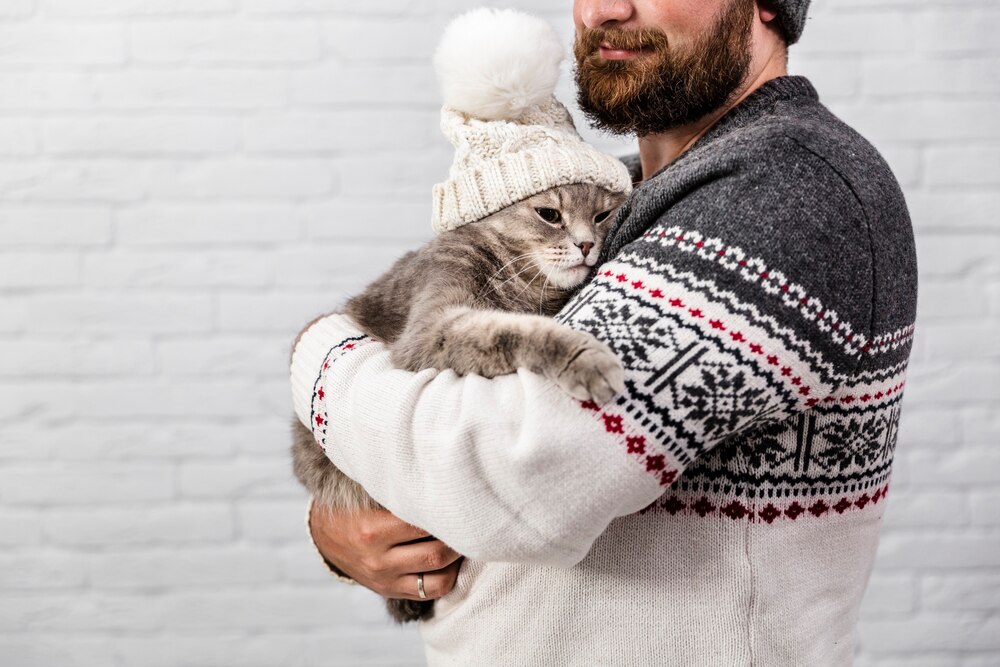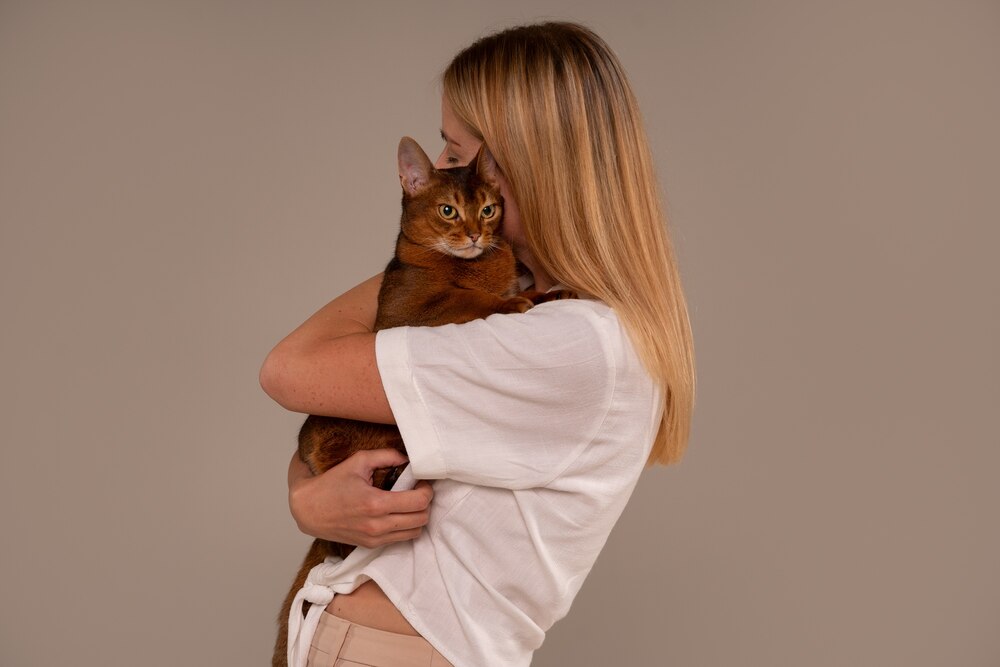Cats are known for their unpredictable behavior, and one common behavior that many cat owners experience is their cat jumping on their back. This can be both surprising and sometimes even painful, but understanding why cats do this can help us prevent it from happening. In this article, we will explore the reasons behind why cats jump on their owner’s back and provide tips on how to stop this behavior.
One possible reason for a cat jumping on their owner’s back is that they are seeking attention or affection. Cats are known to be social animals, and jumping on their owner’s back can be a way for them to get close and receive attention. Another reason could be that they see their owner’s back as a high vantage point, allowing them to observe their surroundings better.

To prevent your cat from jumping on your back, it is important to provide them with alternative ways to seek attention and satisfy their need for high vantage points. This can include providing them with interactive toys, scratching posts, and perches where they can climb and observe their surroundings. Additionally, it is important to discourage the behavior by gently pushing them off your back and redirecting their attention to a more appropriate behavior.
Understanding your cat’s behavior and providing them with appropriate outlets for their needs can help prevent them from jumping on your back. By implementing these tips, you can create a harmonious and enjoyable relationship with your feline friend.
5 Reasons Why Cats Jump on Backs
Cats are known for their unpredictable behavior, and one of the most puzzling actions they often engage in is jumping on people’s backs. Understanding why cats do this can help us better comprehend their complex nature.
The Need for Attention
Cats are attention seekers, and jumping on backs is their way of demanding it. They crave affection and will go to great lengths to get it.
Marking Territory
Cats have scent glands on their paws, and by jumping on backs, they leave their scent as a way of marking their territory. It’s their way of saying, “This human belongs to me.”
Playfulness
Jumping on backs can also be a sign of playfulness. Cats love to engage in interactive activities, and what better way to initiate play than by surprising their human companions?
Seeking Comfort
Cats find comfort in the warmth and security of their owners. Jumping on backs allows them to be close to their favorite humans and feel safe and protected.
Asserting Dominance
In some cases, cats may jump on backs as a way of asserting dominance. By positioning themselves higher than their owners, they establish their authority in the relationship.
Understanding these reasons can help cat owners better respond to their feline friends’ behavior and create a harmonious bond between human and cat.
Understanding Cat Behavior
Cats are fascinating creatures with unique behaviors that can sometimes be puzzling to their human companions. By gaining a deeper understanding of their behavior, you can strengthen the bond between you and your feline friend.
Decoding Body Language
One way to understand your cat’s behavior is by observing their body language. Pay attention to their tail movements, ear positions, and overall posture to decipher their mood and intentions.
Interpreting Vocalizations
Cats communicate through a variety of vocalizations, from purring to meowing. Each sound has a different meaning, and by learning to interpret these vocal cues, you can better understand what your cat is trying to communicate.
Exploring Territory Marking
Cats are territorial animals, and they use various methods to mark their territory. Understanding their marking behaviors, such as scratching and rubbing, can provide insights into their need for security and comfort.
Unraveling Play Behavior
Play is an essential part of a cat’s life, and it serves various purposes, including exercise, mental stimulation, and social bonding. By observing their play behavior, you can better understand their needs and provide appropriate outlets for their energy.
Recognizing Stress and Anxiety
Cats can experience stress and anxiety, which can manifest in various ways, such as excessive grooming or aggression. Recognizing these signs can help you identify and address any underlying issues that may be affecting your cat’s well-being.
5 Advices to Stop Cat Back Jumping
Cats jumping on backs can be a frustrating behavior for many cat owners. However, there are several effective strategies to prevent this behavior and maintain a harmonious relationship with your feline friend.
Establish Boundaries and Consistency
Setting clear boundaries and consistently enforcing them is crucial in stopping cat back jumping. Make sure your cat understands that jumping on your back is not acceptable behavior.
Provide Alternative Surfaces
Cats often jump on backs as a way to seek attention or play. By providing alternative surfaces, such as a scratching post or a cat tree, you can redirect their behavior and provide them with an appropriate outlet for their energy.
Use Positive Reinforcement
Rewarding your cat for good behavior can be highly effective in stopping cat back jumping. Use treats or praise to reinforce positive actions, such as staying off your back.
Utilize Deterrents
There are various deterrents available, such as motion-activated sprays or noise devices, that can discourage cats from jumping on backs. These can be useful tools in training your cat to avoid this behavior.
Seek Professional Help
If all else fails, it may be beneficial to consult a professional cat behaviorist or trainer. They can provide personalized advice and guidance to help you address and resolve the issue of cat back jumping.
Interpreting Cat Back Jumping
Understanding why cats jump on backs can be a perplexing task for cat owners. However, by observing their behavior and body language, you can gain valuable insights into their motives.
Decoding Body Language
Cats communicate through their body language, and deciphering their signals can help you interpret their back jumping behavior. Look for signs such as raised tails, flattened ears, or dilated pupils, which may indicate fear or aggression.
Identifying Triggers
To interpret cat back jumping, it’s crucial to identify the triggers that prompt this behavior. Is it a response to sudden movements, loud noises, or the presence of other animals? By pinpointing the specific triggers, you can take steps to minimize or eliminate them, reducing the likelihood of your cat jumping on backs.
By understanding and interpreting your cat’s back jumping behavior, you can create a harmonious environment that promotes their well-being and prevents any unwanted surprises.
Reasons Why Cats Jump on Backs
Cats are known for their unpredictable behavior, and one common behavior that can be both amusing and frustrating is when they jump on people’s backs. Understanding why cats do this can help you prevent it from happening or address the issue if it becomes a problem.
Curiosity and Playfulness
One reason why cats jump on backs is simply out of curiosity and playfulness. They may see your back as an interesting object to explore or as a potential playmate.
Seeking Attention
Another reason is that cats may jump on backs to seek attention. They may want to be petted or to engage in interactive play with you.
By understanding these reasons, you can take steps to prevent cats from jumping on backs or redirect their behavior to more appropriate outlets.
6. “5 Tips for Training Cats to Stop Jumping on Backs”
Cats can be mischievous creatures, and one common behavior that many cat owners struggle with is their tendency to jump on people’s backs. However, with a little patience and training, you can teach your feline friend to break this habit.
Tip 1: Establish Boundaries
Set clear boundaries for your cat by using verbal cues and body language. Consistently reinforce these boundaries to help your cat understand that jumping on backs is not acceptable behavior.
Tip 2: Provide Alternative Surfaces
Give your cat alternative surfaces to jump on, such as scratching posts or cat trees. Encourage them to use these designated areas instead of your back.
Training your cat to stop jumping on backs may take time and effort, but with these tips, you can effectively teach them appropriate behavior. Remember to be patient and consistent in your training approach, and soon your cat will learn to respect your personal space.
5 Ways to Prevent Cats from Jumping on Backs
Cats jumping on backs can be a nuisance, but there are several effective ways to prevent this behavior. Firstly, provide your cat with plenty of mental and physical stimulation to keep them occupied and less likely to engage in jumping. Secondly, establish clear boundaries by using positive reinforcement techniques and redirecting their attention to appropriate activities. Additionally, ensure that your cat has a designated space, such as a scratching post or a cozy bed, where they can relax and feel secure. Furthermore, consider using deterrents, such as double-sided tape or aluminum foil, on surfaces where your cat tends to jump. Lastly, if the behavior persists, consult with a veterinarian or a professional animal behaviorist for further guidance and advice.
Engage Your Cat with Interactive Toys
Engaging your cat with interactive toys not only provides mental stimulation but also helps redirect their energy away from jumping on backs.
Create a Safe and Comfortable Environment
Creating a safe and comfortable environment for your cat is essential in preventing them from jumping on backs.










